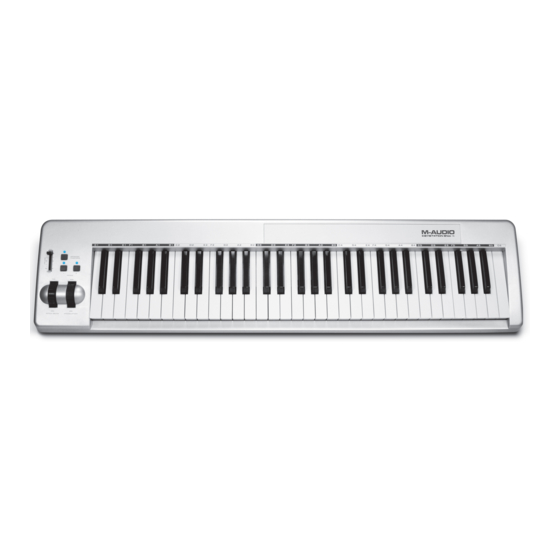
M-Audio Keystation 61es User Manual
61-key mobile usb midi controller
Hide thumbs
Also See for Keystation 61es:
- User manual (78 pages) ,
- User manual (14 pages) ,
- User manual (18 pages)
Table of Contents
Advertisement
Advertisement
Table of Contents

Subscribe to Our Youtube Channel
Summary of Contents for M-Audio Keystation 61es
-
Page 2: Table Of Contents
Contact M-Audio ........ - Page 3 This Page Blank Intentionally...
-
Page 4: English
Connecting Your Keyboard You can power the keyboard either via a powered USB port or an optional external power supply. However, the Keystation 61es is a very low power device and an external power supply should not be necessary. It is recommended that you connect the Keystation 61es... -
Page 5: Windows Xp And Mac Os X
Keystation 61es keyboard is class compliant, it will work without any further installation. Other Operating Systems If you are using an operating system other than OSX or Windows XP, please refer to our website at www.m-audio.com for the latest Keystation 61es drivers for Macintosh or Windows operating systems. -
Page 6: Getting Started
MIDI data. MIDI data gives instructions on how a sound should play, but in order to actually hear that sound you need to configure your music software to read the MIDI data being sent from the Keystation 61es and play the sound back accordingly. This setup will more than likely entail going into an Options or Device Set-Up menu in your music software application and selecting the appropriate device. -
Page 7: Advanced Function Button
Octave Buttons An octave contains 12 notes. Each octave is denoted on your Keystation 61es by black and white sections starting on C. Each octave is given a number. If you press the octave “+” button once, the led above the octave “-“ button will go out, indicating the keyboards’ octave is now shifted up. -
Page 8: Advanced Functions
Advanced functions In addition to setting an octave shift, the two octave “+” and ’“-“ buttons discussed earlier in the manual under the section “Octave Buttons” can also be used to control one of five MIDI functions. In the diagram above, you will see that the first 6 black keys are labeled “DATA = ________.” These keys are used to select the function of the octave buttons. -
Page 9: Transposition
Transposition In some cases it may be useful to reduce or increase the pitch by a number of semitones rather than an entire octave. For example, if you are playing a song with a singer that is having difficulty hitting the top notes, you may want to reduce the pitch by one or two semitones.* This is achieved using a MIDI function called “Transpose.”... - Page 10 Bank LSB and Bank MSB Program Changes are most commonly used to change instruments and voices. However, the number of instruments accessible via Program Changes is limited to 128. Some devices have more than 128 voices and require a different method to access these extra voices.
-
Page 11: Midi - If All Goes Wrong
MIDI - If All Goes Wrong The Keystation 61es has been designed to make working with MIDI on your computer as simple as possible. Nonetheless, you may still experience some difficulties. In many cases, the keyboard is not at fault; the problem lies with the receiving device. To counter this, there... -
Page 12: Trouble-Shooting
We strongly recommend a proper soundcard. Refer to www.m-audio.com for a selection of USB, PCI and Firewire audio cards. If you already have an adequate sound card, try reinstalling the latest drivers for the sound card, or try reducing the buffer sizes of the audio drivers. -
Page 13: Warranty Info
(www.m-audio.com/register). M-AUDIO warrants this product, under normal use, to be free of defects in materials and workmanship for a period of One (1) Year from date of purchase, so long as: the product is owned by the original purchaser, with proof of purchase from an authorized M-AUDIO dealer and, the product has been registered to the original purchaser, the purchaser having returned to M-AUDIO the completed product warranty card. -
Page 14: Appendices - Useful Midi Data
Appendices - Useful MIDI Data Appendix A - General MIDI Instruments 0 Acoustic Grand Piano 32 Acoustic Bass 64 Soprano Sax 96 SFX Rain Piano Bass Reed Synth Effects 1 Bright Acoustic Piano 33 Electric Fingered Bass 65 Alto Sax 97 SFX Soundtrack 2 Electric Grand Piano 34 Electric Picked Bass... - Page 15 Appendix B - Standard MIDI Controller Numbers (MIDI CC’s) 00 Bank Select 46 Controller 46 92 Tremelo Depth 01 Modulation 47 Controller 47 93 Chorus Depth 02 Breath Control 48 Gen Purpose 1 LSB 94 Celeste (De- tune) 03 Controller 3 49 Gen Purpose 2 LSB 95 Phaser Depth 04 Foot Control...









Need help?
Do you have a question about the Keystation 61es and is the answer not in the manual?
Questions and answers